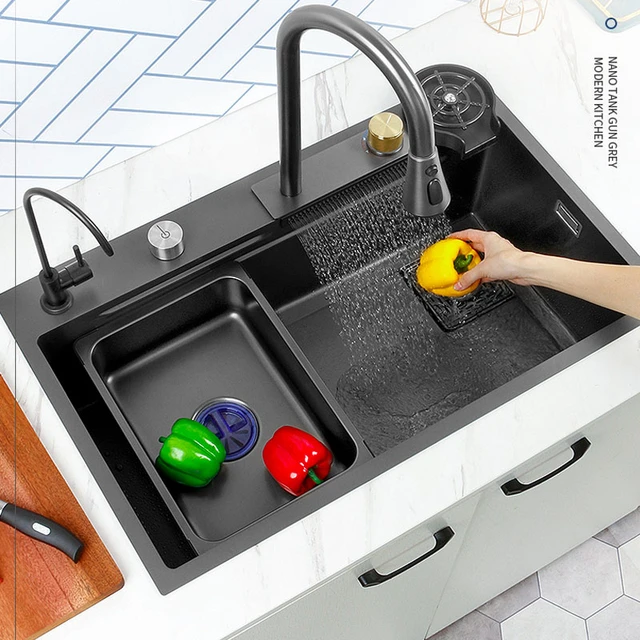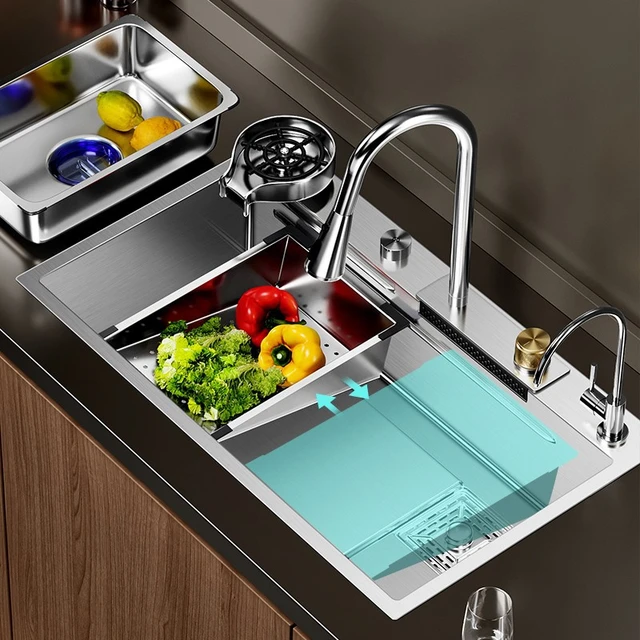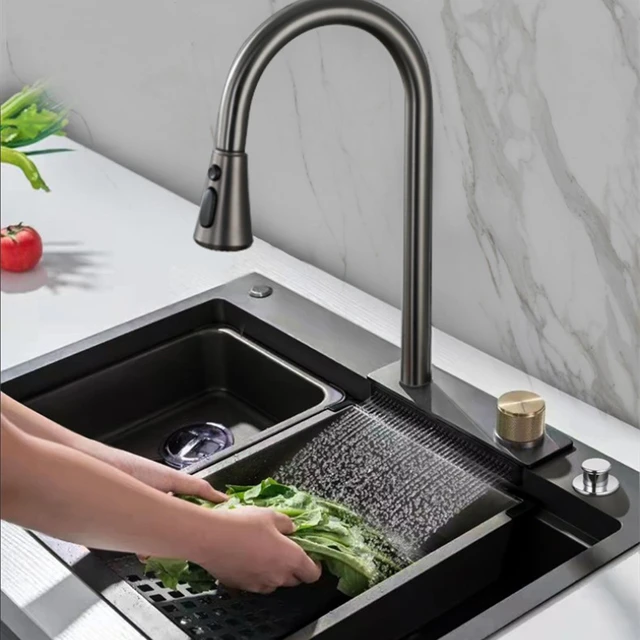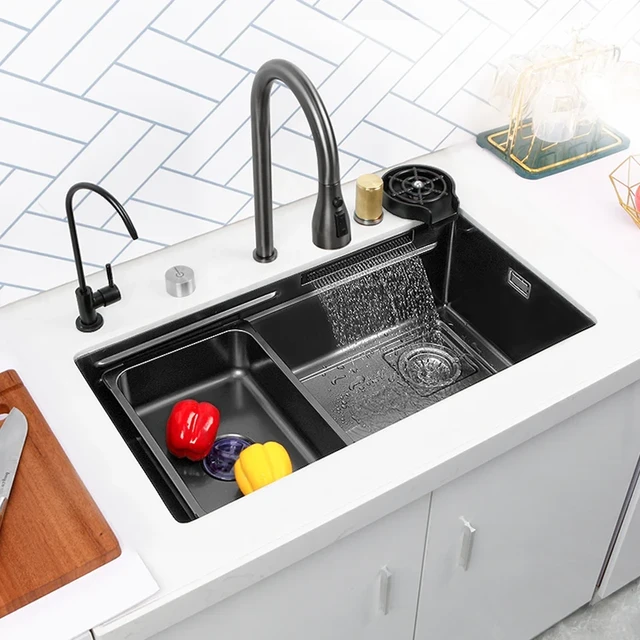Why is my kitchen sink leaking underneath
A dripping faucet is an annoying nuisance, but a leak underneath your kitchen sink can quickly turn into a major headache. Not only is it a source of water damage, but it can also lead to mold growth and structural problems. So, why is your kitchen sink leaking underneath? Let’s dive into the common culprits and explore effective solutions for tackling this problem.
 Understanding the Anatomy of a Kitchen Sink
Understanding the Anatomy of a Kitchen Sink
Before we delve into the reasons behind leaks, it’s essential to understand the basic components of a kitchen sink. This will help you identify the potential source of the leak more effectively.
- Sink Basin: This is the main part of your sink, typically made of stainless steel, porcelain, or composite materials.
- Drain: The drain is the hole at the bottom of the sink that allows water to flow out. It consists of a strainer, a drainpipe, a trap (P-trap), and a vent pipe.
- Faucet: The faucet controls the flow of water into the sink. It has handles, a spout, and internal components like valves and cartridges.
- Supply Lines: These are the pipes that connect the faucet to the water source (hot and cold water lines).
- Waste Line: This pipe connects the P-trap to the main drain line.
Common Reasons Why Your Kitchen Sink is Leaking Underneath
Now that we understand the basic parts of your kitchen sink, let’s pinpoint the potential reasons behind that bothersome leak:
1. Loose or Damaged P-Trap
The P-trap is a curved pipe beneath your sink that prevents sewer gases from entering your home. It is a common culprit for leaks, and the issue often stems from:
- Loose Connections: The P-trap is connected to the sink drain and waste line with nuts and washers. If these connections become loose, water can escape.
- Cracked or Damaged P-Trap: Over time, the P-trap can become cracked, corroded, or damaged, leading to leaks.
- Improper Installation: If the P-trap wasn’t properly installed, it might not be sealed tightly, leading to leaks.
 How to Fix a Leaky P-Trap:
How to Fix a Leaky P-Trap:
- Tighten Connections: Ensure all nuts and washers are securely fastened. You might need a wrench to tighten them properly.
- Replace the P-Trap: If the P-trap is cracked or damaged, you’ll need to replace it. This is a relatively straightforward task, and you can find replacement P-traps at most hardware stores.
2. Leaky Faucet Supply Lines
The supply lines are the pipes that bring hot and cold water to your faucet. They can leak for several reasons:
- Corrosion: Over time, metal supply lines can corrode, leading to leaks.
- Loose Connections: The supply lines are connected to the faucet and water shut-off valves with compression fittings. If these become loose, water can escape.
- Cracked or Damaged Supply Lines: The supply lines can become cracked or damaged due to wear and tear or external pressure.
How to Fix Leaky Supply Lines:
- Tighten Connections: If the connections are loose, use a wrench to tighten them. Be careful not to overtighten, which can damage the fittings.
- Replace the Supply Lines: If the supply lines are corroded, cracked, or beyond repair, it’s best to replace them. You can find replacement supply lines in various materials, like braided stainless steel, copper, or PEX.
 3. Worn-Out Faucet Cartridge or Valves
3. Worn-Out Faucet Cartridge or Valves
The faucet’s internal components, such as the cartridge or valves, can wear out over time. This can lead to leaks around the base of the faucet or from the spout.
How to Fix a Leaky Faucet Cartridge or Valves:
- Replace the Cartridge: If you have a cartridge-style faucet, you can usually replace the cartridge yourself. This is a relatively simple repair that involves removing the old cartridge and installing a new one.
- Replace the Valves: If you have a ball-style faucet, you might need to replace the valves. This is a more complex repair that usually requires a plumber.
4. Damaged Drain Pipe or Waste Line
The drain pipe and waste line carry water from the sink to the main drain. They can become damaged due to:
- Corrosion: Metal drain pipes can corrode over time, leading to leaks.
- Clogs: Clogs in the drain pipe can cause pressure buildup, leading to leaks.
- Cracks or Breaks: The drain pipe can crack or break due to age, improper installation, or external pressure.
How to Fix a Leaky Drain Pipe or Waste Line:
- Clean the Drain: If a clog is causing the leak, try to clear the drain with a plunger or drain snake.
- Replace the Damaged Section: If the drain pipe is corroded, cracked, or broken, you’ll need to replace the damaged section. This may require a plumber.
5. Issues with the Dishwasher or Garbage Disposal
If you have a dishwasher or garbage disposal connected to your kitchen sink, leaks can also originate from these appliances.
- Dishwasher Leaks: The dishwasher’s drain hose can leak, or a leak could originate from the dishwasher’s internal components.
- Garbage Disposal Leaks: A leak from the garbage disposal usually indicates a problem with the drain hose or the seal around the disposal unit.
How to Fix Leaks from Appliances:
- Check the Drain Hose: Inspect the dishwasher drain hose for leaks. If it’s cracked or damaged, you’ll need to replace it.
- Check the Garbage Disposal: If you suspect a leak from the garbage disposal, check the drain hose for leaks or ensure the seal around the disposal unit is intact.
Other Potential Causes
While the above are some of the most common reasons for leaks, there are some other factors to consider:
- Improper Sealing: Improperly sealed connections around the sink, faucet, or drain can lead to leaks.
- Water Pressure Issues: High water pressure can strain pipes and fittings, increasing the risk of leaks.
- Material Deterioration: The materials used in your kitchen sink, like pipes and fittings, can deteriorate over time, making them more prone to leaks.
 How to Diagnose and Fix Leaks Yourself
How to Diagnose and Fix Leaks Yourself
Before you call a plumber, try these steps to diagnose and fix the leak yourself:
- Turn off the Water: Shut off the water supply to the sink by turning the shut-off valves located underneath the sink.
- Identify the Source: Carefully inspect the area under the sink and locate the exact point where the water is leaking.
- Check for Loose Connections: Once you’ve located the leak, check if any connections are loose and tighten them if necessary.
- Check the P-Trap and Supply Lines: Carefully inspect the P-trap and supply lines for cracks, corrosion, or damage.
- Replace Damaged Parts: If you discover any damaged parts, you can usually find replacements at your local hardware store.
- Turn the Water Back On: Once you’ve made repairs, slowly turn the water back on and check for leaks again.
When to Call a Plumber
While many repairs can be handled yourself, some situations warrant calling a plumber:
- Complex Leaks: If you’re unable to identify the source of the leak or if it involves complex plumbing systems, it’s best to consult a plumber.
- Difficult Repairs: If the repair involves accessing pipes behind walls or requires specialized tools, a plumber will have the expertise and equipment to handle the situation effectively.
- Safety Concerns: If you suspect a significant leak or if you’re concerned about your safety, it’s crucial to call a professional plumber immediately.
Preventing Future Leaks
Once you’ve fixed the current leak, take steps to prevent future problems:
- Regular Inspection: Periodically inspect your kitchen sink for leaks, cracks, or signs of corrosion.
- Maintain Water Pressure: Ensure the water pressure in your home is within the recommended range to prevent stress on pipes and fittings.
- Protect from Freezing: During cold weather, take steps to protect your pipes from freezing, as this can lead to leaks.
 Conclusion
Conclusion
why is my kitchen sink leaking underneath
A leaking kitchen sink can be a frustrating and potentially damaging issue. By understanding the common reasons behind leaks and following our step-by-step guide, you can diagnose and fix many problems yourself. However, for complex leaks or those involving safety concerns, it’s always best to call a qualified plumber. By taking proactive steps to maintain and inspect your kitchen sink, you can prevent future leaks and keep your kitchen watertight.



